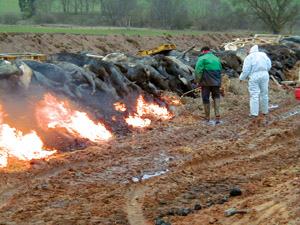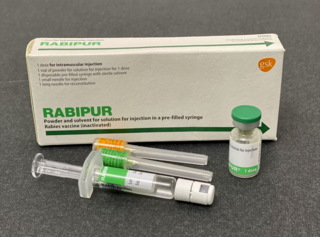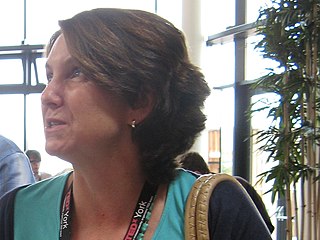Related Research Articles

The Department for Environment, Food and Rural Affairs (DEFRA) is a department of His Majesty's Government in the United Kingdom responsible for environmental protection, food production and standards, agriculture, fisheries and rural communities in the entire United Kingdom. Concordats set out agreed frameworks for co operation, between it and the Scottish Government, Welsh Government and Northern Ireland Executive, which have devolved responsibilities for these matters in their respective nations.

The outbreak of foot-and-mouth disease in the United Kingdom in 2001 caused a crisis in British agriculture and tourism. This epizootic saw 2,000 cases of the disease in farms across most of the British countryside. Over 6 million cows and sheep were killed in an eventually successful attempt to halt the disease. Cumbria was the worst affected area of the country, with 893 cases.
The Pirbright Institute is a research institute in Surrey, England, dedicated to the study of infectious diseases of farm animals. It forms part of the UK government's Biotechnology and Biological Sciences Research Council (BBSRC). The institute employs scientists, vets, PhD students and operations staff.
The Veterinary Medicines Directorate (VMD) is an Executive Agency of the Department for Environment, Food and Rural Affairs (Defra) seeking to protect public health, animal health, the environment and promoting animal welfare by assuring the safety, quality and efficacy of veterinary medicines in the United Kingdom.
The State Veterinary Service (SVS) was, from 1938 to 2007, an executive agency of the Department for Environment, Food and Rural Affairs (Defra), a department of the Government of the United Kingdom. It was the government's delivery agent, responsible for animal health and welfare in England, Scotland and Wales.

The 2007 United Kingdom foot-and-mouth outbreak occurred when the discharge of infectious effluent from a laboratory in Surrey led to foot-and-mouth disease (FMD) infections at four nearby farms. The infections were detected via regular livestock testing by the Department for Environment, Food and Rural Affairs (Defra).
James Marfell Scudamore CB was the Chief Veterinary Officer (CVO) of the United Kingdom and for Department for Environment, Food and Rural Affairs (DEFRA) from April 1997 until he retired March 2004, and prior to this he was Assistant Chief Veterinary Officer, Scotland from 1990 to 1996. He was made a Companion of the Order of the Bath in the 2004 New Year Honours. He was succeeded as CVO by Debby Reynolds.
The Chief Veterinary Officer is an official in the British government, who is head of veterinary services in the United Kingdom. Wales, Scotland and Northern Ireland also each have a Chief Veterinary Officer.
William Howard Guest Rees CB was the Chief Veterinary Officer of the United Kingdom from August 1980 to May 1988.
Frederick John Landeg was the Chief Veterinary Officer (CVO) of the United Kingdom and for Department for Environment, Food and Rural Affairs (DEFRA), from November 2007 to April 2008.

The rabies vaccine is a vaccine used to prevent rabies. There are several rabies vaccines available that are both safe and effective. Vaccinations must be administered prior to rabies virus exposure or within the latent period after exposure to prevent the disease. Transmission of rabies virus to humans typically occurs through a bite or scratch from an infectious animal, but exposure can occur through indirect contact with the saliva from an infectious individual.

Rabies is a viral disease that causes encephalitis in humans and other mammals. It was historically referred to as hydrophobia due to the symptom of panic when presented with liquids to drink. Early symptoms can include fever and abnormal sensations at the site of exposure. These symptoms are followed by one or more of the following symptoms: nausea, vomiting, violent movements, uncontrolled excitement, fear of water, an inability to move parts of the body, confusion, and loss of consciousness. Once symptoms appear, the result is virtually always death, regardless of treatment. The time period between contracting the disease and the start of symptoms is usually one to three months but can vary from less than one week to more than one year. The time depends on the distance the virus must travel along peripheral nerves to reach the central nervous system.
Almost all human deaths caused by rabies occur in Asia and Africa. There are an estimated 59,000 human deaths annually from rabies worldwide.
Fred Brown was a British virologist and molecular biologist.
European bat 2 lyssavirus(EBLV-2) is one of three rabies virus-like agents of the genus Lyssavirus found in Daubenton's bats in Great Britain. Human fatalities have occurred: the naturalist David McRae who was bitten by a Daubenton's bat in Scotland, became infected with EBLV-2a and died in November 2002. It must now be assumed that the virus is present in bats in the UK. Testing of dead bats by MAFF/DEFRA over the last decade indicates that the overall incidence of infection is likely to be very low, although limited testing of live Daubenton's bats for antibodies suggests that exposure to EBLV-2 may be more widespread. Nevertheless, infected bat bites have caused human deaths so appropriate precautions against infection must be taken. The Department of Health’s recommendation is that people regularly handling bats should be vaccinated against rabies. Included in this category are all active bat workers and wardens, and those regularly taking in sick and injured bats. The Statutory Nature Conservation Organisations and the Bat Conservation Trust urge all those involved in bat work to ensure that they are fully vaccinated and that they receive regular boosters. Bats should not be handled by anyone who has not received these vaccinations. Even when fully vaccinated, people should avoid being bitten by wearing appropriate bite-proof gloves when handling bats. Any bat bite should be thoroughly cleansed with soap and water and advice should be sought from your doctor about the need for post-exposure treatment. Further information is available from the SNCOs, the Bat Conservation Trust or the Health Protection Agency (HPA) /Scottish Centre for Infection and Environmental Health (SCIEH).

Sarah Cleaveland is a veterinary surgeon and Professor of Comparative Epidemiology at the University of Glasgow.

Nicola Jane Spence is the Chief Plant Health Officer and Deputy Director for plant and bee health at the Department for Environment, Food and Rural Affairs.

The Sarawak rabies outbreak is an ongoing rabies outbreak in the state of Sarawak in Malaysia. Until 6 December 2022, 49 confirmed rabies cases and 44 deaths have been reported.

Geronimo was a stud alpaca that resided at Shepherds Close Farm in Wickwar, South Gloucestershire, England. After Geronimo tested positive for bovine tuberculosis (bTB), a highly publicised controversy erupted surrounding his fate and the British government's policy of euthanising any animal that tested positive for bTB. After a number of court battles, Geronimo was euthanised.
Sir Percy John Luxton Kelland, known as Sir John Kelland, was the Chief Veterinary Officer in the Diseases of Animals Branch at the Ministry of Agriculture and Fisheries between 1932 and 1938.
References
- 1 2 3 4 5 "Chief Medical Officer - brief biography of Debby Reynolds, includes a photograph". DEFRA. Archived from the original on 26 September 2007. Retrieved 10 August 2007.
- 1 2 "Suspected case of bat rabies in Staines". Health Protection Agency. 28 September 2004. Archived from the original on 26 July 2007. Retrieved 10 August 2007.
- 1 2 3 4 5 6 7 8 "Medical and veterinary sciences faculty news for alumni (winter 2005/06)" (PDF). University of Bristol. 2005. Archived from the original (PDF) on 18 April 2007. Retrieved 11 August 2007.
- 1 2 "Notable alumni - Faculty of Medical & Veterinary Sciences". University of Bristol. 2007. Archived from the original on 13 August 2007. Retrieved 11 August 2007.
- 1 2 "National News - New Year Honours: Tory donor among Brown's first list". Financial Times. 29 December 2007. Retrieved 5 January 2008.[ permanent dead link ](subscription required)
- ↑ "Sheep virus 'low risk to the UK'". BBC. 19 September 2006. Retrieved 11 August 2007.
- ↑ "Farm infected with foot-and-mouth". BBC News. 3 August 2007. Retrieved 11 August 2007.
- 1 2 "Chief vet leaves with plaudits after four years service". DEFRA. 9 November 2007. Archived from the original on 6 September 2008. Retrieved 10 November 2007.
- ↑ "Honour for Dolly sheep scientist". BBC News. 29 December 2007. Retrieved 5 January 2008.
- 1 2 3 4 5 "Profile, Debby Reynolds". BBC. 2007. Archived from the original on 30 June 2008. Retrieved 11 August 2007.